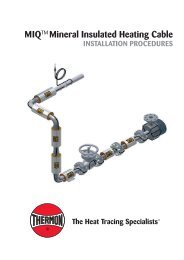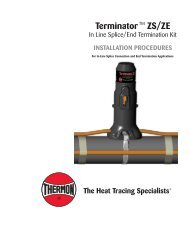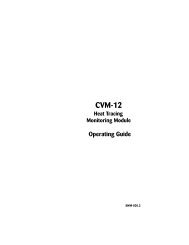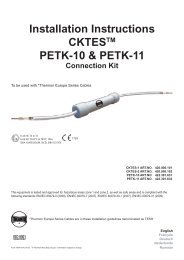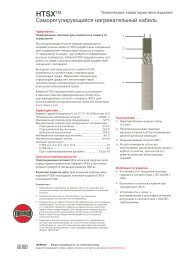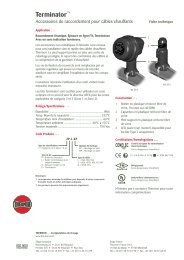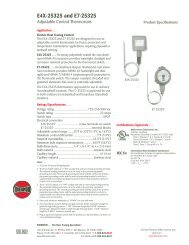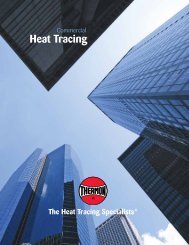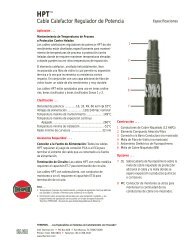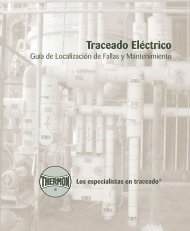Frost Heave Design Guide - Thermon Manufacturing Company
Frost Heave Design Guide - Thermon Manufacturing Company
Frost Heave Design Guide - Thermon Manufacturing Company
You also want an ePaper? Increase the reach of your titles
YUMPU automatically turns print PDFs into web optimized ePapers that Google loves.
Type FLX Freezer Floor<strong>Frost</strong> <strong>Heave</strong> ProtectionDESIGN GUIDECommercial Products
Type FLX TMFreezer Floor<strong>Frost</strong> <strong>Heave</strong> ProtectionDESIGN GUIDEContentsIntroduction...............................................................................2Application Information........................................................ 2-3Product DescriptionCharacteristicsApprovalsBasis for a Good <strong>Design</strong> ...........................................................3<strong>Frost</strong> <strong>Heave</strong> Protection <strong>Design</strong> Outline................................ 3-6Step 1: Establish <strong>Design</strong> ConditionsStep 2: Determine Conduit SpacingStep 3: Branch Circuit Breaker SizingStep 4: Determine the System LayoutStep 5: Establish Control Method to Operate SystemSystem Components .................................................................7<strong>Frost</strong> <strong>Heave</strong> Protection Bill of Materials ..................................7General Specification ................................................................8For additional information about frost heave protection of freezer floorswith heat tracing contact <strong>Thermon</strong>.
Freezer <strong>Frost</strong> <strong>Heave</strong> ProtectionIntroduction . . .The substrata of freezer floors can withstand cold temperaturesfor a period of time; however, the ground temperaturewill eventually drop below freezing. At that point, if water ispresent in the substrate, frost heaving of the freezer floor willoccur. FLX cables, when run in conduit in the substrate, providefrost heave protection by maintaining the ground temperatureabove freezing.Small or large frost heave protection applications can be easilydesigned utilizing FLX self-regulating heating cables. Establishingthe proper design, procurement and installation of materialsfor a project will ensure a successful heat tracing systeminstallation.The information contained within this design guide will assistengineers and contractors in establishing a successful electricheat tracing design and installation based on:Freezer temperatureAvailable power supplyFreezer sizeSubstrate makeupMonitoring/control requirementsAfter following the designated steps in this design guide, the engineer/contractorwill be able to design, specify or establish a billof materials for a freezer floor frost heave protection system.If design parameters are different than those in this designguide, contact your local <strong>Thermon</strong> factory representative foradditional information.Characteristics . . .Product Description . . .FLX self-regulating heating cable includes a parallel circuit constructionthat allows the cable to be cut to length and terminatedin the field. The semiconductive heating matrix providesthe self-regulating feature. FLX heating cable varies its heatoutput to compensate for the surrounding conditions along theentire length of a circuit.Whenever the heat loss of the freezer floor increases, the heatoutput of the cable increases. Conversely, when the heat lossdecreases, the cable reacts by reducing its heat output. Thisself-regulating feature occurs along the entire length of a heattracing circuit to ensure each point receives the requiredamount of heat while conserving energy.FLX 8 heating cables are rated for nominal heat outputs of5.5 W/ft in counduit at 40°F (18 W/m in conduit at 4°C)when powered at 110 to 120 Vac or 208 to 277 Vac. FLX selfregulatingcables include a tinned copper braid to providegrounding and polyolefin outer jacket for additional mechanicalprotection for the cable.Bus WireBus wire ..................................................................... 16 AWG nickel-plated copperHeating core ........................................................... radiation cross-linked polyolefinPrimary dielectric insulation ................................... radiation cross-linked polyolefinMetallic braid ..............................................12 AWG (equivalent size) tinned copperOuter jacket ......................................................................................... OJ, polyolefinMinimum bend radius ....................................................................... 1.25" (32 mm)Supply voltage ................................................................... 110-120 or 208-277 VacCircuit protection ...................................... 30 mA ground-fault protection requiredMax. operating temperature (power-on) .............................................. 150°F (65°C)Max. exposure temperature (power-off) .............................................. 185°F (85°C)Minimum installation temperature ....................................................... -60°F (-51°C)SemiconductiveHeating MatrixRadiation Cross-LinkedPolyolefin InsulationTinned Copper BraidPolyolefin Outer Jacket2
DESIGN GUIDEProduct Approvals . . . Tests . . . Compliances<strong>Thermon</strong>’s Type FLX self-regulating heating cable carries thefollowing major agency approval:Underwriters Laboratories Inc. ®In addition to the numerous agency tests performed, FLX hasalso passed the testing guidelines outlined in IEEE Standard515.1, Recommended Practice for the Testing, <strong>Design</strong>, Installation,and Maintenance of Electrical Resistance Heat Tracing forCommercial Applications.FLX Cables Meet or Exceed the Following Tests . . .TestStandard FollowedDielectric Withstand IEEE 515.1 (4.2.1)Water Resistance IEEE 515.1 (4.2.3)Thermal Stability IEEE 515.1 (4.2.6)Flammability IEEE 515.1 (4.2.7)Deformation IEEE 515.1 (4.2.8)Cold Bend IEEE 515.1 (4.2.10)Moisture Resistance IEEE 515.1 (4.5.1)Pull Strength IEEE 515.1 (4.5.2)Basis for a Good <strong>Design</strong> . . .As freezers and refrigerated facilities are typically maintained attemperatures below freezing, the substrata below these facilitiesresults in temperatures below freezing. If moisture ispresent, it will begin to freeze, expand and eventually causethe floor to heave.Due to differences found in construction, substrata and poweravailability, no particular design may be effective in all situationsto maintain subsoil temperatures above freezing.This design guide helps the reader evaluate different scenariosso that each project may be designed to meet specific requirements.<strong>Frost</strong> <strong>Heave</strong> Protection <strong>Design</strong> Outline . . .The following steps outline the design process for an FLX 8freezer floor frost heave protection system (required for eachseparate facility):Step 1: Establish <strong>Design</strong> ConditionsCollect relevant project data:a. Facility sizeLength of areaWidth of areab.Facility substrateConcrete cap thicknessInsulation type and thicknessSubstrate type and thicknessc. TemperatureFacility temperatureStep 2: Determine Conduit SpacingBased on:a. Thermal insulationType of insulationThickness of insulationb.Minimum operating temperatureStep 3: Determine Maximum Circuit Length and ElectricalLoadBased on:a. Operating voltageb.Branch circuit breaker sizec. Circuit lengthsStep 4: Determine the System LayoutReview freezer floor plans to establish:a. Conduit layoutb.Junction box locationsc. Pull box locationsStep 5: Establish Control Method Needed to OperateSystema. Thermostatic controlb.RTDs with HeatChek ® systemsThe step-by-step procedures which follow will provide thereader with the detailed information required to design andspecify a fully functional frost heave protection system.3
Freezer <strong>Frost</strong> <strong>Heave</strong> ProtectionStep 1: Establish <strong>Design</strong> ConditionsThe following data is required in determining the heat load fora frost heave protection system.Size of Facility . . . Total surface area including physical dimensionsof all areas with floor temperatures expected to be at orbelow freezing.Floor Substrata . . .• Finished Floor—In freezer applications, this surface is typicallyconcrete. As this surface does not generally affect theoverall heat load, this design guide assumes a 4" (10 cm)layer of concrete.• Type and Thickness of Insulation—This design guide isbased on industry standards with a thermal conductivity of0.20 Btu in/hr ft 2 °F. The design selection tables in Step 2allow for an insulation thickness of both 4" and 6" (10 cmand 15 cm).• Substrate—Generally composed of concrete or gravel, theheating cable is placed within this layer, allowing even heatdistribution between heating passes.Facility Operating Temperatures . . . Determine the low operatingtemperature of the storage facility. It is not uncommonfor the required operating temperatures to change; therefore,use the lowest expected temperature for calculating heat loads.Step 2: Determine Conduit SpacingThe primary factors in determining heat and correspondingconduit spacing requirements in frost heave protection systemsare thermal insulation and minimum operating temperatures.Insulation does not stop the flow of heat; it merely slows theheat transfer down depending on the type and thickness of insulationpresent.This guide assumes a core soil temperature of 55°F (13°C) forbelow-grade installations. As with installations above grade,thermal insulation around the perimeter should be considered.The primary objective of the heating system is to replace theheat lost through the thermal insulation and maintain temperaturesbelow the insulation at or above 40°F (4°C). This is generallyaccomplished by placing the conduits on 4' to 8' (1.2 mto 2.4 m) center-to-center spacing.Using the design criteria provided, refer to <strong>Design</strong> SelectionTables 2.0 to determine the required conduit spacing. A 50%safety factor has been included in the values shown.The design selection chart provides specific heat loss requirementsbased on the following:• Freezer operating temperatures• Insulation thickness• Fixed insulation thermal conductivityIf the thermal insulation type or thickness for your specificneeds is different from that shown, contact your local <strong>Thermon</strong>factory representative for design assistance.FreezerOperatingTemperatureTable 2.0 <strong>Design</strong> SelectionFloor Insulation 1(R-20)Conduit Spacing ft (m)Floor Insulation 1(R-30)-40°F (-40°C) -- 4.5 (1.4)-20°F (-29°C) 4.0 (1.2) 6.0 (1.8)-10°F (-23°C) 5.0 (1.5) 7.5 (2.3)0°F (-18°C) 6.0 (1.8) 8.0 (2.4)10°F (-12°C) 8.0 (2.4) 8.0 (2.4)20°F (-6°C) 8.0 (2.4) 8.0 (2.4)Notes . . .1. Insulation values are based on industry standards with a thermal conductivity of 0.20Btu in/hr ft 2 °F. Insulation with R-20 and R-30 are based on 4" and 6" (10 cm and 15cm) thickness respectively.4
DESIGN GUIDEStep 3: Maximum Circuit Lengths and Total Heating Load<strong>Thermon</strong>’s Type FLX heating cable is designed to operate onstandard line voltages of 120, 208, 220, 240 or 277 Vac.Cable selection is contingent upon the following variables:• Operating voltage• Available branch circuit breaker size• Circuit length requirements• Maximum allowable circuit lengthTable 3.0 provides the maximum continuous circuit length allowablebased on line voltage and the circuit breaker rating. A40°F (4°C) start-up is assumed.CatalogNumberTable 3.0 Cable SelectionServiceVoltageMaximum Circuit Length15 Amp 20 Amp 30 AmpFLX 8-1 110-120 130 (40) 175 (53) 220 (67)FLX 8-2 208-277 260 (80) 350 (105) 440 (135)Notes . . .• Ratings are based on dry conduit conditions (no moisture or water inside conduit).Contact <strong>Thermon</strong> if start-up conditions are other than 40°F (4°C).• The National Electrical Code and Canadian Electrical Code require ground-fault protectionof equipment for each branch circuit supplying electric heating equipment. Checklocal codes for ground-fault protection requirements.Formula 3.0 Estimating Circuit LengthCircuit Length = (Freezer Floor Area ft 2 ÷ Conduit Spacing) + End Allowances + Termination AllowancesEvery heat tracing circuit will require some additional heating cable to make the various terminations.Use the following guidelines to determine the amount of extra cable required:• End Allowances . . . Allow an additional 4' of FLX cable for each end. Length of cable required to extend from conduit located in subfloor tothe junction box located above the finished floor. (See Detail Below)• Termination Allowances . . . Allow an additional 2' of FLX cable for each termination. Length of heating cable inside junction box.Option: FLX 8 Self-Regulating heating cable may extend between junction boxes inside a protective conduit thus reducing the need to make atermination at each junction box. If this approach is used, the termination allowance becomes the center-to-center distance between conduits.Example . . .Branch circuit requirements of an individual heater circuit aredependent upon the supply voltage and the total length ofheater cable installed. Determine an estimated circuit lengthfor an individual circuit by using Formula 3.0.As an example, assume the freezer floor for a given facility tobe 32' x 45' (1440 ft 2 ) with 8' center-to-center conduit spacing.Use Formula 3.0 to determine an estimated circuit lengthfor the individual circuit requirements:Circuit Length = (1440 ÷ 8) + 32 1 + 16 2Total footage of FLX can be estimated . . .Total FLX cable required = 228 linear feetNotes . . .1. End allowance includes 8 junction boxes mutiplied by 4 feet each to equal 32 feet.2. Termination allowance includes 8 terminations multiplied by 2 foot each to equal 16 feet.32'Junction Box45'Power feed wire inside conduit.FLX may extend between boxes.See Option in Formula 3.0 above.8' O.C.FLX Heating Cable inside ConduitFormula 3.1 Estimating Operating LoadNominal Electrical Load = (Total Cable Required x 5.5 W/ft)The total operating load of a FLX frost heave system can be determinedby inserting the appropriate values into Formula 3.1.Example . . .FloorInsulationSubfloorJunction BoxConduitEnd AllowanceUsing Formula 3.1 total output (in watts) can be estimated . . .Total output = 228 x 5.5Total output = 1254 watts5
Freezer <strong>Frost</strong> <strong>Heave</strong> ProtectionStep 4: Determine System LayoutHeating cables used for frost heave protection systems can beinstalled in metallic or nonmetallic conduits under the insulatedfloor. These conduits allow the heater cable to be replacedwith new cable should the need arise. Conduits usedfor heating cable should be a minimum of 3/4" inside diameter.Where the size of the freezer permits, conduit layout can utilizea looping design allowing all junction/pull boxes to be locatedalong one wall. If the length requires, straight line runs locatingjunction boxes along walls opposite each other may be used.The conduit layout and number of bends should be arrangedin order that the pulling force of the heating cable does not exceed667 newtons (150 pounds) (refer to Details 4.1 and 4.2).As per the National Electrical Code, Article 348-10, “Thereshall not be more than the equivalent of four quarter bends(360 degrees total) between pull points, e.g., conduit bodiesand boxes.”Location of junction boxes must allow accessibility to the wiringwithout removing any part of the building or other substanceused to establish finished grade. Typically junctionboxes are located 12" to 24" (30 to 61 cm) above the finishedfloor (refer to Detail 4.3).Once the locations of the junction boxes are known, beginconduit layout using the information provided in the earliersteps.• Determine layout using center-to-center spacing selectedin Step 2.• Do not exceed continuous circuit lengths shown in Table3.0.• For installation in concrete subslab, secure conduit to reinforcingsteel using steel tie wire.• For installation in gravel subslab, secure conduit using theaddition of rebar or steel spikes to maintain recommendedspacing.Step 5: Establish Control Method to Operate the SystemAll frost heave protection systems should be controlled. Thereare two basic ways to control and monitor a frost heave protectionsystem:• Recommended: Proportional control using a ResistanceTemperature Detector (RTD) with HeatChekSystem—Turnssystem on proportionally based on subfloor temperatures.At maximum heat loss system is 100% on. RTDs, to be locatedin a minimum of 1-1/4"conduit between electricheat tracing conduits, have the ability to limit the cable’spower output to closely match heat loss (refer to Detail 5.1).• Alternate: On/Off Thermostatic Control—Turns system onand off based on subfloor temperatures. Sensor is locatedin 1-1/4" conduit between electric heat tracing conduits(not shown).Detail 4.1 Looping <strong>Design</strong>RTD Sensor ConduitConduit with Heating CableDetail 4.2 Straight Line <strong>Design</strong>RTD Sensor ConduitConduit with Heating CableDetail 4.3 Junction BoxDetail 5.1 HeatChek System6
DESIGN GUIDESystem Components . . .A system with Type FLX heating cable for frost heave protectionwill typically include the following components:1. FLX 8 self-regulating heating cable2. TBX-3LC power connection kit3. ET-6C end termination kit4. JB-K nonmetallic junction box5. Adjustable Thermostat (not shown)6. RTD-500-3 resistance temperature detector7. HeatChek control and monitoring system8. CL “Electric Heat Tracing” caution labels peel and stick tojunction boxes, power distribution and control panel(s), oras required by code or specification (not shown)1FLX Self-Regulating He423<strong>Frost</strong> <strong>Heave</strong> Protection Bill of Materials . . .Use the design outline steps on page 3 and the detailed stepson pages 4 through 6 to assemble an FLX bill of materials. It isrecommended that some additional heating cable per circuitbe allowed to compensate for variations between the existingdrawings and the actual installation area.7Quantity DescriptionFLX 8-1 OJ or FLX 8-2 OJ Self-Regulating Heating Cable(refer to Table 3.0 on page 5 for proper cable type)TBX-3LC Power Connection KitET-6C End Termination KitJB-K Nonmetallic Junction Box (for cable termination)CL “Electric Heat Tracing” Caution Labels (peel-andsticklabels attach to junction boxes, power distributionand control panel(s), or as required by code orspecification)Adjustable Thermostat (not shown)RTD-500-3 Resistance Temperature Detector (for usewith the HeatChek system)HeatChek Control and Monitoring System67
Freezer General <strong>Frost</strong> Specification <strong>Heave</strong> ProtectionPart 1 . . . GeneralFurnish and install a complete UL Listed system of heaters andcomponents approved specifically for freezer floor frost heaveprotection. The heat tracing system shall conform to IEEEStandard 515.1-1995.Part 2 . . . Products1. The self-regulating heating cable shall be of parallel constructionand shall consist of two nickel-plated copper buswires embedded in a radiation cross-linked semiconductivepolymer core. The heater shall include a tinned copperbraid to provide grounding and polyolefin outer jacket foradditional mechanical protection for the cable2. The heater shall operate on line voltage of (select: 110-120,208, 220, 240, 277 or 480) Vac without the use of transformers.3. The heating cable shall be suitable for use with metallic andnonmetallic conduit.4. Power connections and end seal terminations shall be madein junction/pull boxes as described under Part 5, Installation.5. For additional energy conservation, the heating cable shallbe controlled by (select):a. An adjustable thermostat based on current loads foreach circuit.b. A resistance temperature detector (RTD) used in conjunctionwith a microprocessor-based temperature controland monitoring module. Control and monitoringshall be capable of switching up to 30 amps per circuit at120/208/220/240/277 Vac.c. When the load of the heating cable exceeds the ratingof the temperature controller, the heating cable shall becontrolled through an appropriately sized contactor.6. All heating cable core will be permanently marked with themanufacturer’s identification number for traceability.7. Acceptable products and manufacturers are:a. FLX 8 Self-Regulating heating cable and accessories asmanufactured by <strong>Thermon</strong> Industries, Inc.b. HeatChek ® systems and components as manufacturedby <strong>Thermon</strong> Industries, Inc.8. Refer to the manufacturer’s “Freezer Floor <strong>Frost</strong> <strong>Heave</strong> Protection<strong>Design</strong> <strong>Guide</strong>” for design details, insulation requirements,maximum circuit lengths and accessory information.Part 3 . . . System Performance1. Heating cable layout should be based on (select preferreddesign method):a. Manufacturer’s frost heave protection design guide.b. Section 6.5, <strong>Frost</strong> <strong>Heave</strong> Prevention, of the IEEE Standard515.1-1995, Recommended Practice for the Testing,<strong>Design</strong>, Installation, and Maintenance of ElectricalResistance Heat Tracing for Commercial Applications.2. System performance shall be based on temperatures belowthe insulation barrier of 40°F (4°C) during freezer operation.Part 4 . . . Manufacturer1. The manufacturer shall demonstrate experience manufacturingand designing freezer floor frost heave protectionsystems with self-regulating heating cables. This experiencemay be documented with a list of ____ projects utilizing atleast 500 feet (152 m) of self-regulating heating cable.2. Manufacturer’s Quality Assurance Program shall be certifiedto the ISO 9001 Standard.Part 5 . . . Installation1. Heating cable shall be installed in a minimum 3/4" conduitwithin the base layer of the substrate, approximately 2"(5 cm) below the insulation barrier.2. Installer shall follow manufacturer’s installation instructionsand design guide for proper installation and layout methods.Deviations from these instructions could result in performancecharacteristics other than intended.3. Power connections and end terminations shall be located inNEMA 4 junction boxes. Heating cable located betweenjunction boxes and substrate shall be encased in conduit.4. All installations and terminations must be made to conformto the NEC and any other applicable national or local coderequirements.5. Locate the RTD sensors as indicated on the system drawings.6. Circuit breakers supplying power to the heat tracing mustbe equipped with a minimum of 30 mA ground-fault equipmentprotection (5 mA GFCI should not be used as nuisancetripping may result).7. The electrician (see Division 16–Electrical) shall connectsystem to power.Part 6 . . . Testing1. Heating cable shall be tested with a 2,500 Vdc megohmeter(megger) between the heating cable bus wires and the heatingcable’s metallic braid. While a 2,500 Vdc megger test isrecommended, the minimum acceptable level for testing is1,000 Vdc. This test should be performed a minimum ofthree times:a. Prior to installation while the cable is still on reel(s).b. After installation of heating cable and completion ofpower connection and end terminations.c. Upon completion of concrete cap pour.2. The minimum acceptable level for the megger readings is20 megohms, regardless of the circuit length.3. Results of the megger readings should be recorded andsubmitted to the construction manager.8
<strong>Thermon</strong> . . . The Heat Tracing Specialists ®100 <strong>Thermon</strong> Drive • PO Box 609 • San Marcos, TX 78667-0609Phone: 512-396-5801 • Facsimile: 512-754-2431 • 800-730-HEATwww.thermon.comForm CPD1038-0603 © <strong>Thermon</strong> <strong>Manufacturing</strong> Co. Printed in U.S.A.



